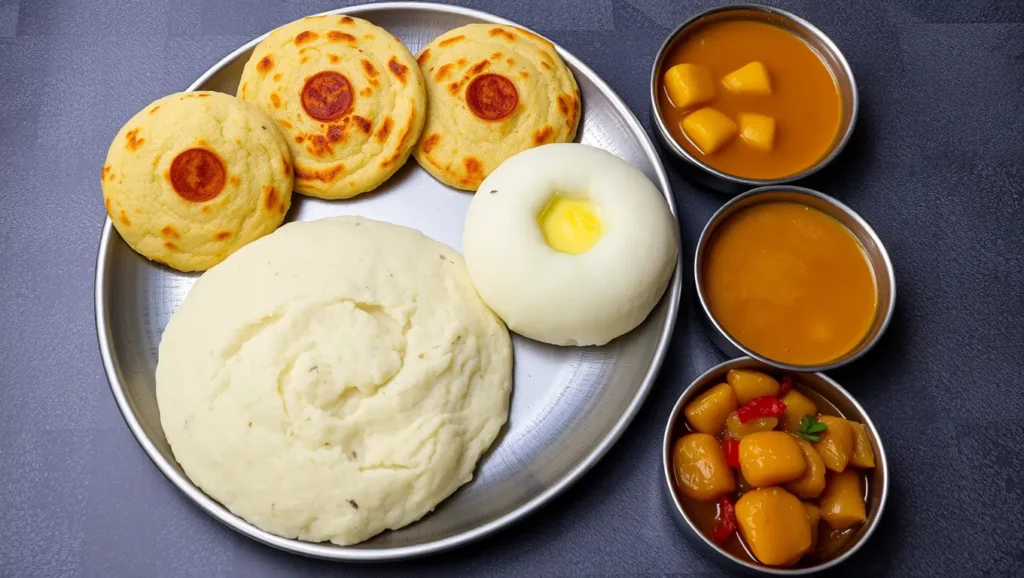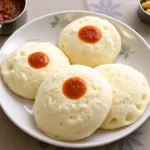Introduction
South Indian breakfast dishes are known for their unique flavors, nutritional value, and variety. From crispy dosas to fluffy idlis, these dishes have been a staple in South Indian households for generations. In this blog post, we’ll explore some popular South Indian breakfast options, their ingredients, and nutritional information.
Table of Contents
Popular South Indian Breakfast Dishes
1. Idli
Idli is a soft, steamed cake made from fermented rice and black lentil batter. It’s light, easily digestible, and often served with coconut chutney and sambar.
2. Dosa
Dosa is a thin, crispy pancake made from fermented rice and black lentil batter. It can be plain or stuffed with various fillings like potatoes, vegetables, or paneer.
3. Vada
Vada is a savory, deep-fried snack made from black lentil or chickpea flour. It’s crispy on the outside and soft on the inside, often served with chutney and sambar.
4. Upma
Upma is a savory porridge-like dish made from semolina or rice flour, vegetables, and spices. It’s a quick and easy breakfast option that’s both filling and nutritious.
5. Pongal
Pongal is a comforting rice and lentil dish cooked with ghee, black pepper, cumin, and ginger. It’s often served with coconut chutney and sambar.
Ingredients
Here’s a table showing the main ingredients for each of these popular South Indian breakfast dishes:
| Dish | Main Ingredients |
|---|---|
| Idli | Rice, Black lentils (Urad dal), Salt, Water |
| Dosa | Rice, Black lentils (Urad dal), Salt, Water |
| Vada | Black lentils (Urad dal) or Chickpea flour, Salt, Spices |
| Upma | Semolina or Rice flour, Vegetables, Oil, Mustard seeds |
| Pongal | Rice, Yellow lentils (Moong dal), Ghee, Black pepper, Cumin |
Nutritional Information
Here’s a table showing the approximate nutritional information for a typical serving of each dish:
| Dish | Calories | Protein (g) | Carbs (g) | Fat (g) |
|---|---|---|---|---|
| Idli | 39 | 2 | 8 | 0.1 |
| Dosa | 133 | 3 | 26 | 2 |
| Vada | 97 | 4 | 14 | 3 |
| Upma | 250 | 6 | 40 | 9 |
| Pongal | 230 | 7 | 35 | 8 |
Note: Nutritional values may vary based on preparation methods and serving sizes.
Health Benefits
South Indian breakfast dishes offer several health benefits:
- High in complex carbohydrates for sustained energy
- Good source of protein from lentils
- Low in fat (except for deep-fried options like vada)
- Rich in vitamins and minerals from added vegetables and spices
- Fermented dishes like idli and dosa are good for gut health
Conclusion
South Indian breakfast dishes offer a delightful combination of flavors, textures, and nutritional benefits. Whether you’re looking for a light start to your day with idlis or a heartier meal like pongal, there’s something for everyone in South Indian cuisine. Try incorporating these dishes into your breakfast routine for a tasty and healthy start to your day.
Frequently Asked Questions (FAQs)
What are some popular South Indian breakfast dishes?
South Indian cuisine offers a variety of delicious breakfast options. Some of the most popular dishes include:
- Idli: Steamed rice cakes
- Dosa: Thin, crispy pancakes made from fermented rice and lentil batter
- Vada: Savory, deep-fried lentil doughnuts
- Upma: A savory semolina dish
- Pongal: A comforting rice and lentil porridge
- Uttapam: Thick pancakes with toppings
I remember trying idli for the first time during a trip to Chennai. The soft, fluffy texture paired with coconut chutney was a revelation!
Are South Indian breakfasts healthy?
Many South Indian breakfast dishes are considered healthy due to their ingredients and preparation methods:
- High in protein: Lentils and rice combinations provide complete proteins
- Rich in fiber: Whole grains and vegetables contribute to digestive health
- Low in fat: Many dishes are steamed or griddle-cooked rather than deep-fried
- Fermented foods: Dishes like idli and dosa contain probiotics from fermentation
However, it’s important to note that some dishes can be high in carbohydrates, so portion control is key.
What are the common side dishes served with South Indian breakfast?
South Indian breakfasts are often accompanied by flavorful side dishes:
- Sambar: A tangy lentil soup with vegetables
- Chutney: Coconut, tomato, or mint varieties are common
- Podi: Spicy powder made from lentils and spices
- Ghee: Clarified butter for added flavor
- Filter Coffee: A strong, aromatic coffee to complete the meal
I find that the combination of a main dish with sambar and chutney creates a perfect balance of flavors and textures.
How long does it take to prepare a typical South Indian breakfast?
The preparation time can vary depending on the dish:
- Quick options (15-30 minutes):
- Upma
- Pongal
- Uttapam (if batter is ready)
- Dishes requiring more time (1-2 hours or overnight preparation):
- Idli and Dosa (batter needs fermentation)
- Vada (soaking and grinding lentils)
In my experience, planning ahead and preparing batter the night before can save a lot of time in the morning.
Can South Indian breakfast dishes be made gluten-free?
Yes, many South Indian breakfast dishes are naturally gluten-free or can be easily adapted:
- Naturally gluten-free options:
- Idli
- Dosa
- Vada
- Pongal
- Dishes that may need adaptation:
- Upma (use gluten-free semolina or millets)
- Some chutneys (ensure no wheat-based thickeners are used)
Always check ingredients carefully, especially in restaurant settings, to ensure gluten-free preparation.
What utensils are typically used to make South Indian breakfast?
Some essential utensils for South Indian breakfast preparation include:
- Idli steamer: For making idlis
- Dosa tawa: A flat griddle for cooking dosas and uttapams
- Karahi or deep frying pan: For making vadas
- Pressure cooker: Used for cooking rice and lentils quickly
- Wet grinder: For making smooth batters
I’ve found that investing in a good quality dosa tawa has greatly improved my dosa-making skills at home.
Are South Indian breakfast dishes suitable for vegans?
Many South Indian breakfast dishes are vegan-friendly or can be easily modified:
- Naturally vegan options:
- Idli
- Dosa
- Upma (when made with oil instead of ghee)
- Most chutneys
- Dishes that may need adaptation:
- Pongal (omit ghee)
- Some versions of vada (check for dairy ingredients)
When eating out, it’s always a good idea to ask about specific ingredients to ensure vegan preparation.
How do South Indian breakfasts differ from North Indian breakfasts?
There are several key differences between South and North Indian breakfasts:
- Ingredients: South Indian dishes often use rice and lentils, while North Indian dishes may include more wheat-based items
- Flavors: South Indian cuisine tends to be tangier and uses more coconut, while North Indian food may be creamier and use more dairy
- Cooking methods: South Indian breakfast often involves steaming and fermenting, while North Indian breakfast may include more frying and baking
In my opinion, both cuisines offer delicious breakfast options, each with its unique charm and flavors.
Can South Indian breakfast dishes be made ahead and reheated?
Some South Indian breakfast dishes can be prepared in advance:
- Idli and dosa batter: Can be made and fermented overnight
- Chutneys and sambar: Can be prepared a day ahead and refrigerated
- Idlis: Can be steamed in advance and reheated in a steamer or microwave
However, dishes like dosas and vadas are best enjoyed fresh. In my experience, reheating dosas can make them lose their crispiness.
What are some tips for making perfect dosas at home?
Creating the perfect dosa can take practice, but here are some helpful tips:
- Use the right proportions of rice and lentils in the batter
- Allow sufficient fermentation time (usually 8-12 hours)
- Ensure the batter consistency is neither too thick nor too thin
- Heat the tawa (griddle) properly before pouring the batter
- Use a circular motion to spread the batter thinly
- Add oil or ghee around the edges for crispiness
I’ve found that the key to a crispy dosa is a well-seasoned tawa and the right batter consistency.



